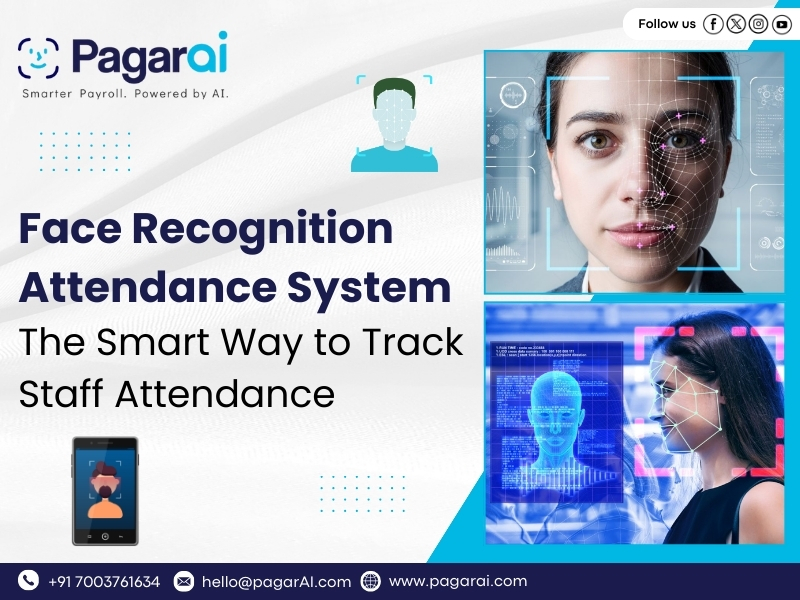Manual attendance logs and punch cards are outdated, error-prone, and easy to manipulate. Businesses today need accuracy, security, and real-time tracking — and that’s where a face recognition attendance system steps in.
By combining biometric technology with AI, this system doesn’t just mark who’s in — it connects attendance to performance analytics, AI-powered productivity tracking, and even employee monitoring software for complete workforce insights.
What is a Face Recognition Attendance System?
A face recognition attendance system is a biometric solution that identifies and verifies an employee’s face to log attendance.
It uses advanced image processing and AI algorithms to ensure accurate verification, even if:
- The employee’s hairstyle changes
- They wear glasses or a mask
- Lighting conditions vary
How It Works
- Face Scan: The camera captures the employee’s facial features.
- Feature Mapping: AI maps facial landmarks and creates a unique face ID.
- Verification: The system compares the face ID to the stored database.
- Attendance Logging: Successful matches are recorded in real time.
- Integration: Data is synced with employee attendance management systems for payroll and compliance.
Key Features That Make It a Game-Changer
1. Contactless Attendance
Unlike fingerprint scanners or manual sign-ins, facial recognition is hygienic and frictionless.
2. Real-Time Tracking
Managers can see attendance logs instantly, even for remote offices.
3. Anti-Spoofing Technology
Prevents fraud by detecting 2D photos, videos, or masks.
4. Cloud Integration
Allows easy syncing with employee tracking apps and staff monitoring software.
5. AI-Powered Insights
When paired with an AI-powered productivity tracker, attendance data can be matched with productivity scores.
Why Businesses Are Switching to Face Recognition Attendance
1. Accuracy and Fraud Prevention
Eliminates “buddy punching” and false time logs.
2. Time Savings
Employees clock in and out in under a second.
3. Cost Efficiency
Reduces admin costs associated with manual timekeeping.
4. Data Integration
Links directly with employee monitoring programs for deeper analysis.
Face Recognition Attendance in Different Work Environments
1. Corporate Offices
Tracks late arrivals, early departures, and absences.
2. Manufacturing Plants
Manages shift workers across multiple entry points.
3. Field Service Teams
Mobile face recognition via employee tracking apps for remote workers.
4. Schools and Institutions
Automates attendance for teachers and students.
Integrating with Other Workforce Tools
To unlock its full potential, integrate a face recognition attendance system with:
- AI-powered productivity trackers – Connect attendance with work output.
- Employee monitoring software – Gain insights into employee activity.
- Employee attendance management systems – Automate payroll and compliance reports.
- Staff monitoring software – Get department-level tracking and performance metrics.
Privacy and Compliance Considerations
Since face recognition captures biometric data, it’s essential to:
- Get employee consent
- Follow data protection laws (GDPR, CCPA)
- Secure data storage with encryption
- Limit access to authorized personnel only
The AI Advantage
By connecting AI facial recognition with AI-powered productivity tracking, businesses can go beyond attendance.
They can see:
- Who is most productive after arriving early
- How breaks affect task completion rates
- Which attendance patterns align with top performance
Future Trends in Face Recognition Attendance
- Emotion Recognition: Detect stress or fatigue
- Hybrid Workforce Adaptation: Track both in-office and remote attendance
- Integration with Smart Office Systems: Automatic door access and workspace booking
- Predictive Attendance Analytics: Forecast absenteeism
Conclusion: The Future is AI-Driven
The face recognition attendance system is no longer just a futuristic concept — it’s a necessity for modern businesses.
When combined with employee monitoring software, employee tracking apps, and AI-powered productivity trackers, it transforms from a simple clock-in tool into a complete workforce intelligence solution.
Businesses that embrace this technology now will be ahead in accuracy, productivity, and employee satisfaction.



